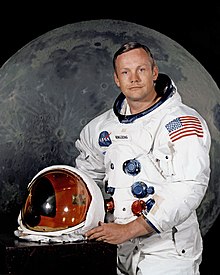Neil Armstrong
| Neil Armstrong | |
|---|---|

|
|
| USAF / NASA astronaut | |
| Born | Neil Alden Armstrong August 5, 1930 Near Wapakoneta, Ohio, U.S. |
| Died | August 25, 2012 (aged 82) Cincinnati, Ohio, U.S. |
|
Previous occupation
|
Naval aviator, test pilot |
|
Purdue University, B.S. 1955 University of Southern California, M.S. 1970 |
|
| Rank | Lieutenant (junior grade), United States Navy |
|
Time in space
|
8 days, 14 hours, 12 minutes, and 30 seconds |
| Selection |
1958 USAF Man In Space Soonest 1960 USAF Dyna-Soar 1962 NASA Group 2 |
|
Total EVAs
|
1 |
|
Total EVA time
|
2 hours 31 minutes |
| Missions | Gemini 8, Apollo 11 |
|
Mission insignia
|
|
| Awards |
|
Neil Alden Armstrong (August 5, 1930 – August 25, 2012) was an American astronaut and the first person to walk on the Moon. He was also an aerospace engineer, naval aviator, test pilot, and university professor. Before becoming an astronaut, Armstrong was an officer in the U.S. Navy and served in the Korean War. After the war, he earned his bachelor's degree at Purdue University and served as a test pilot at the National Advisory Committee for Aeronautics (NACA) High-Speed Flight Station, where he logged over 900 flights. He later completed graduate studies at the University of Southern California.
A participant in the U.S. Air Force's Man in Space Soonest and X-20 Dyna-Soar human spaceflight programs, Armstrong joined the NASA Astronaut Corps in 1962. He made his first space flight as command pilot of Gemini 8 in March 1966, becoming NASA's first civilian astronaut to fly in space. He performed the first docking of two spacecraft, with pilot David Scott. This mission was aborted after Armstrong used some of his reentry control fuel to prevent a dangerous spin caused by a stuck thruster, in the first in-flight space emergency.
...
Wikipedia

